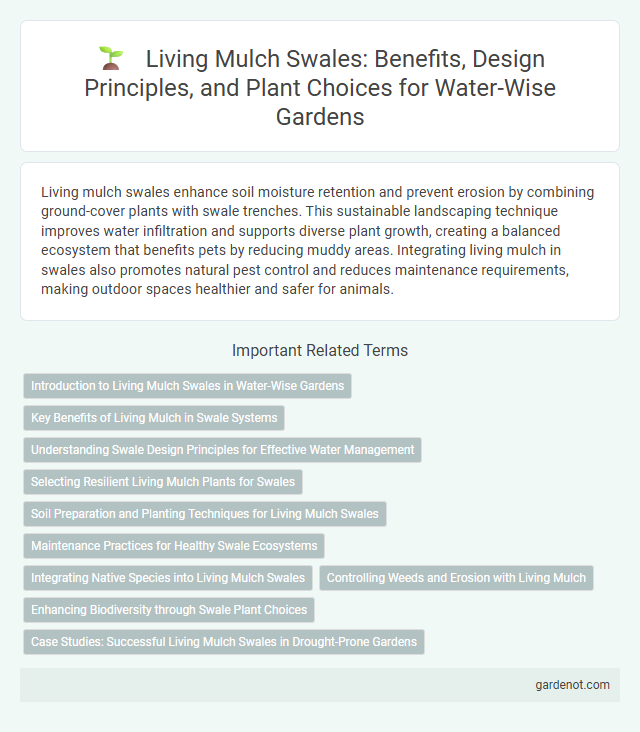Living mulch swales enhance soil moisture retention and prevent erosion by combining ground-cover plants with swale trenches. This sustainable landscaping technique improves water infiltration and supports diverse plant growth, creating a balanced ecosystem that benefits pets by reducing muddy areas. Integrating living mulch in swales also promotes natural pest control and reduces maintenance requirements, making outdoor spaces healthier and safer for animals.
Introduction to Living Mulch Swales in Water-Wise Gardens
Living mulch swales integrate low-growing, water-efficient plants into swale designs to enhance soil moisture retention and reduce erosion. These swales support native vegetation like clover or creeping thyme, which improve soil structure and promote biodiversity while minimizing water use. Incorporating living mulch swales is a sustainable strategy for water-wise gardens aiming to optimize rainwater capture and conservation.
Key Benefits of Living Mulch in Swale Systems
Living mulch in swale systems enhances soil moisture retention by reducing evaporation and improving water infiltration rates. It suppresses weed growth naturally, lowering maintenance needs while promoting biodiversity and soil health through organic matter addition. These benefits collectively support sustainable land management and increase the resilience of swale ecosystems against erosion and nutrient runoff.
Understanding Swale Design Principles for Effective Water Management
Living mulch swale systems maximize water infiltration and soil stabilization by integrating low-growing vegetation within swale contours, enhancing groundwater recharge and erosion control. Effective swale design incorporates slope gradients between 1-5%, appropriate soil composition, and strategic plant selection to optimize water retention and minimize runoff. Applying these principles supports sustainable stormwater management, reduces flood risks, and promotes ecosystem resilience.
Selecting Resilient Living Mulch Plants for Swales
Selecting resilient living mulch plants for swales requires prioritizing species with deep root systems and high drought tolerance to enhance soil stabilization and water infiltration. Native grasses, clover varieties, and groundcovers like creeping thyme provide erosion control while supporting biodiversity and reducing maintenance needs. Plants with nitrogen-fixing capabilities improve soil fertility, promoting long-term swale functionality and ecological balance.
Soil Preparation and Planting Techniques for Living Mulch Swales
Soil preparation for living mulch swales requires thorough loosening and enrichment with organic matter to enhance moisture retention and nutrient availability. Selecting drought-tolerant, deep-rooted cover crops like clover or creeping thyme ensures effective ground coverage and soil stabilization. Planting techniques emphasize spacing and layering to maximize soil infiltration, minimize erosion, and promote symbiotic plant growth within the swale ecosystem.
Maintenance Practices for Healthy Swale Ecosystems
Living mulch swales require regular maintenance practices such as controlled mowing and periodic weeding to prevent invasive species from dominating and ensure diverse plant growth. Soil health must be monitored through mulching and organic amendments to maintain nutrient balance and moisture retention for optimal swale function. Consistent inspection of water flow and erosion signs allows timely intervention, preserving the ecological integrity and water filtration capabilities of the living mulch swale system.
Integrating Native Species into Living Mulch Swales
Incorporating native species into living mulch swales enhances soil stabilization and biodiversity while improving water infiltration and retention. Native plants such as purple coneflower (Echinacea purpurea) and little bluestem (Schizachyrium scoparium) are well-adapted to local climate and soil conditions, promoting resilience against erosion and drought. This integration supports local ecosystems by providing habitat for pollinators and beneficial insects, reinforcing the ecological value of swales in sustainable watershed management.
Controlling Weeds and Erosion with Living Mulch
Living mulch swales utilize ground-cover plants to suppress weed growth effectively and prevent soil erosion by stabilizing the surface layer. The dense vegetation of living mulch reduces the exposure of soil to wind and water runoff, significantly minimizing erosion risks in swale environments. By maintaining soil moisture and enhancing organic matter, living mulch contributes to healthier soil structure, promoting long-term stability and weed control in swale systems.
Enhancing Biodiversity through Swale Plant Choices
Selecting diverse, native plants for living mulch swales significantly enhances local biodiversity by providing habitats and food sources for pollinators, birds, and beneficial insects. Deep-rooted species improve soil structure and water infiltration, supporting healthier ecosystems within the swale. Incorporating a mix of grasses, legumes, and flowering plants ensures year-round cover and nutrient cycling, fostering resilient and sustainable biodiversity-rich landscapes.
Case Studies: Successful Living Mulch Swales in Drought-Prone Gardens
Case studies from drought-prone gardens illustrate that living mulch swales significantly enhance soil moisture retention by reducing evaporation and improving infiltration. Native drought-tolerant plants like clover, creeping thyme, and native grasses planted as living mulch within swales have demonstrated increased plant health and resilience during prolonged dry periods. These successes highlight the swale-living mulch combination as an effective landscape management practice for sustainable water conservation and drought mitigation.
Living mulch swale Infographic

 gardenot.com
gardenot.com